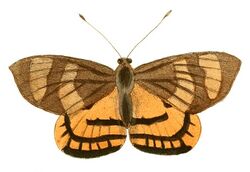Biology:Ceretes thais
| Ceretes thais | |
|---|---|

| |
| Illustration by Dru Drury | |
| Scientific classification | |
| Kingdom: | |
| Phylum: | |
| Class: | |
| Order: | |
| Family: | |
| Genus: | |
| Species: | C. thais
|
| Binomial name | |
| Ceretes thais (Drury, 1782)[1]
| |
| Synonyms | |
| |
Ceretes thais is a moth in the Castniidae family. It is found in Brazil . Superficially it looks very like a butterfly, and was originally placed by Dru Drury in the "Papilio (Danaus Festivus)" group which mostly corresponds with modern Nymphalidae.
Description
Upper side: Antennae brown. Thorax, abdomen, and anterior wings red brown; the latter having two streaks or bars of a lighter colour crossing them from the anterior edges to the posterior and external ones; one crossing the middle of the wing, the other nearer the tips. Posterior wings orange; the lower part black along the external edge, whereon are placed a row of square orange coloured spots, those next the upper corners reaching to the edge; a black line also crosses these wings, beginning just below the body, and running almost across to the upper corner.
Under side: Palpi and thorax red-brown. Abdomen yellowish. Anterior wings yellowish clay coloured, with three black lines crossing them transversely, the middle one being the broadest. Posterior wings orange brown, with a small white spot placed near the centre. Margins of the wings plain. Wing-span 2 1⁄2 inches (64 mm).[2]
References
| Wikimedia Commons has media related to Ceretes thais. |
- ↑ Ceretes at funet
- ↑ Drury, Dru (1837). Westwood, John. ed. Illustrations of Exotic Entomology. 3. pp. 22-23. pl. XVI..
Wikidata ☰ Q2363426 entry
 |

